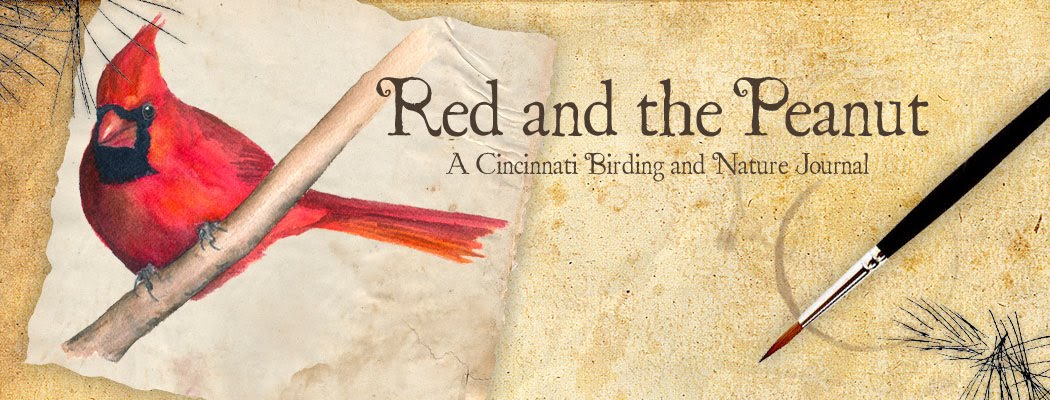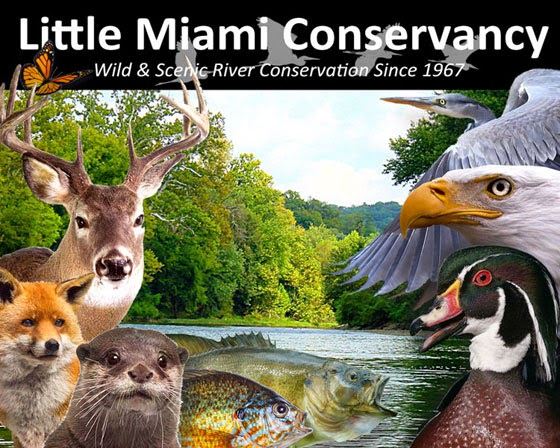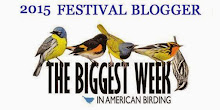This post picks up right where
the previous post left off...in the middle of the huge stand of phragmites along the boardwalk at the Maumee Bay Lodge. At that time Common Yellowthroats were stealing the show with their happy song, but just a few steps away, a slew of Marsh Wrens were gurgling out their bubbly song luring me over their way. The little dynamos were on both sides of the boardwalk near the observation deck, singing and moving through the reeds. One male would sound off, and another would reply...then another on the other side would sing, until the entire marsh was a mish-mash of wren music, but not one would come out of hiding to say, "Hi!" So I did what any birder would do. I sat down, listened, and waited. The boardwalk was empty, so there were no humans to scare the wrens away, and eventually, this little fellow popped up, giving me a glimpse of his cute self...
 |
| A male Marsh Wren peeks through the reeds along the boardwalk at Maumee Bay Lodge. |
Why was I lucky enough to see this little fellow? Well...our little Marsh Wren was sharing his territory with a pair of Common Yellowthroats, or perhaps it's more accurate to say the yellowthroats had encroached on our wren's digs. Who knows, but with human eyes and imagination, it appeared the Common Yellowthroat had let out with one too many
"witchety-witchety-witchety woos," and Mr. Wren had had enough. "Be gone, ye yellow-throated thing" seemed to be the call at hand, because suddenly, our wren popped up, gave the Common Yellowthroat what looked like the stink eye, sang his bubbly spring song for all he was worth, and dove back down to the depths of the reeds where he bubbled out more notes to prove his point. Of course, this is probably all fantasy, but it worked out well for me because I was finally able to photograph this little cutie.
 |
| Marsh Wrens are famous for being heard and not seen. They love to move around near the base of the reeds, singing while they are down there, taunting humans who hover about with binocs and cameras. |
Marsh Wrens are adorable. Their tail feathers are often cocked nice and high, and their constant motion turns them into little imps...and who can resist an imp? I sat for a while without moving, just listening and watching the male wrens periodically pop up in the air and then flutter back down to the watery safety of the reeds, singing the whole time. They were keeping an eye on their territories, and also possibly building "dummy nests." In early spring, males build several nests hoping to catch the eye of a ladylove. The nests are round and hang between the reeds. Eventually, the female picks the nest she likes and then lines it with cattail down.
(Male House Wrens build several dummy nests in their territory as well, but they use nest boxes and other types of cavities. The female also picks her favorite location and finishes off the nest. A few summers ago, we were able to witness some of this behavior in our backyard.
Click here to watch a video of our backyard House Wrens feeding their nestlings.
 |
| Singing in the reeds, just singing in the reeds... |
Hey...when you're finished with that nest, can I use it?
Here's something cool I read about a few weeks ago in
Birds of Lake, Pond, and Marsh: Water and Wetland Birds of Eastern North America, by John Eastman. On pages 231-232, Eastman mentions that when Marsh Wrens leave their nests, bumblebees often move in, lining the nests with cattail down to raise their own broods.
_______________________________________
...to say I've fallen behind is an understatement! These photos go all the way back to May 9, 2016 when I was in Toledo for the
Biggest Week in American Birding warblerfest.






















